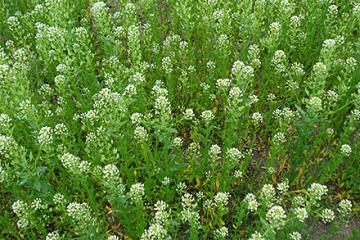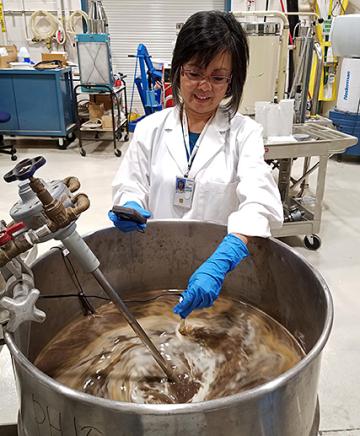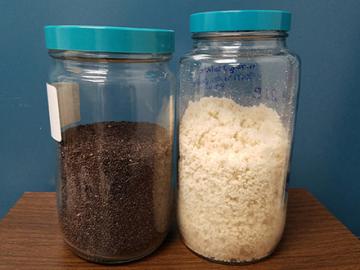Hidden in Plain Sight

Pennycress produces a small white flower. (Photo by Terry Isbell, D1969-2)
ARS Scientists Transform an Overlooked Weed into a Stunning Success
It’s been said that success is the combination of preparation and chance. When it comes to scientific discovery, there is a third element, too: curiosity.
It was a late spring day in 2002 when Terry Isbell and Steve Cermak found themselves walking through a field near Peoria, IL. The open spaces along their path were lined with pennycress, a plant that had made its way over from China before running wild, and now covers much of the American landscape. Isbell, an ARS research chemist who has since retired, was suddenly struck by the familiar and yet unknown plant; he leaned down and plucked one from the ground. Together with Cermak, who is now the research leader of the Bio-oils Research Unit at the National Center for Agricultural Utilization Research (NCAUR) Lab, he brought the plant back to the lab, where the two performed a quick assay. Most people considered pennycress a weedy nuisance. But could it be useful? No one had ever thought to ask.
As it turned out, the answer was yes – but only after Isbell was able to tame its wild nature. In its natural form, pennycress has a highly variable flowering and seed maturation period. With careful line selection and development, Isbell was able to develop a tight flowering plant where all the seeds matured uniformly and could be harvested, leading to a commercially relevant crop. Ultimately, his simple moment of curiosity birthed what may be not only a fuel, but an animal feed, a cover crop and an ingredient in human food as well.
Biofuel has long been a goal of agricultural researchers, and it was one of the first possible uses that they explored with pennycress. With as much as 36% oil content (nearly twice the amount in soybeans), the seeds were a very promising source. Since those early days, the effort to fly jets and propel cars with the plant seed oil has received a significant boost from a commercial partnership with a private company where development continues, with promising results.
At the same time, researchers have been exploring whether the oily-seeded plant might help address other needs, too. Pennycress has not disappointed. Once the oil has been extracted from the seeds, the meal can be processed further for animal feed and human food applications, said Roque Evangelista, research chemist at NCAUR. Evangelista has done extensive work on pennycress oil processing, including heading a pilot processing plant and producing oil that was converted to biodiesel, as well as producing the meal. He is one of several researchers who have joined the quest to discover new uses for this versatile plant.
Alongside him in that search is Milagros (Mila) Hojilla-Evangelista, a research chemist at NCAUR, who has homed in on a multitude of possible uses for the plant in human food. Pennycress turns out to be quite high in protein; that protein, Hojilla-Evangelista notes, can stabilize a foam, a useful property for the growing dairy alternative market; it also has potential as a binder that could provide shape and texture for products like plant-based meat alternatives.
Beyond possible products, there are also broad benefits in growing pennycress. In the upper Midwest, it is common for farmers to grow rotations of corn and soybeans, alternating the two summer annual crops from one year to the next. However, this practice leaves the soil without plant cover between autumn and spring, making it susceptible to erosion and unwanted loss of soil nutrients over time. By planting pennycress as a winter annual crop between corn and soybean production, farmers can reduce some of the unintended harms of conventional Midwest crop rotations.
“Pennycress can take up as much as 90% of the excess nitrogen that’s left behind by corn and wheat after harvest in the fall,” said Russ Gesch, research plant physiologist with the North Central Soil Conservation Research Lab, in Morris, MN. “Springtime is critical for us, because that’s when most of that nitrogen gets leached into groundwaters or it turns to nitrous oxide and goes up in the atmosphere. Nitrous oxide is 300 times more potent than CO2 in terms of global warming. By having pennycress cover on the soil at this time, it’s taking up that excess nitrogen, not allowing it to get into the groundwater, it’s keeping it in the cropping system.
“It also prevents erosion, when you’ve got living cover out there on the landscape,” he added. “Pennycress flowers earlier than almost any other plant on the landscape, and when beekeepers are bringing their bees back to the upper Midwest, which is a primary area that they keep them in during the summertime, there’s forage – pollen and nectar from those flowering plants. Pollinators have been suffering. Pennycress is another alternative forage source for honeybees early in the spring and summer, and that’s huge too. Those are some of the issues that society is really looking at, that it wants to find solutions for. This is one solution.”
From fueling vehicles, to humans, to soil revitalization, pennycress is ripe with potential. It’s a lot for a tiny white flowering plant to accomplish, but with the right perspective and a little curiosity, perhaps anything is possible. – by Kathryn Markham, ARS Office of Communications.



